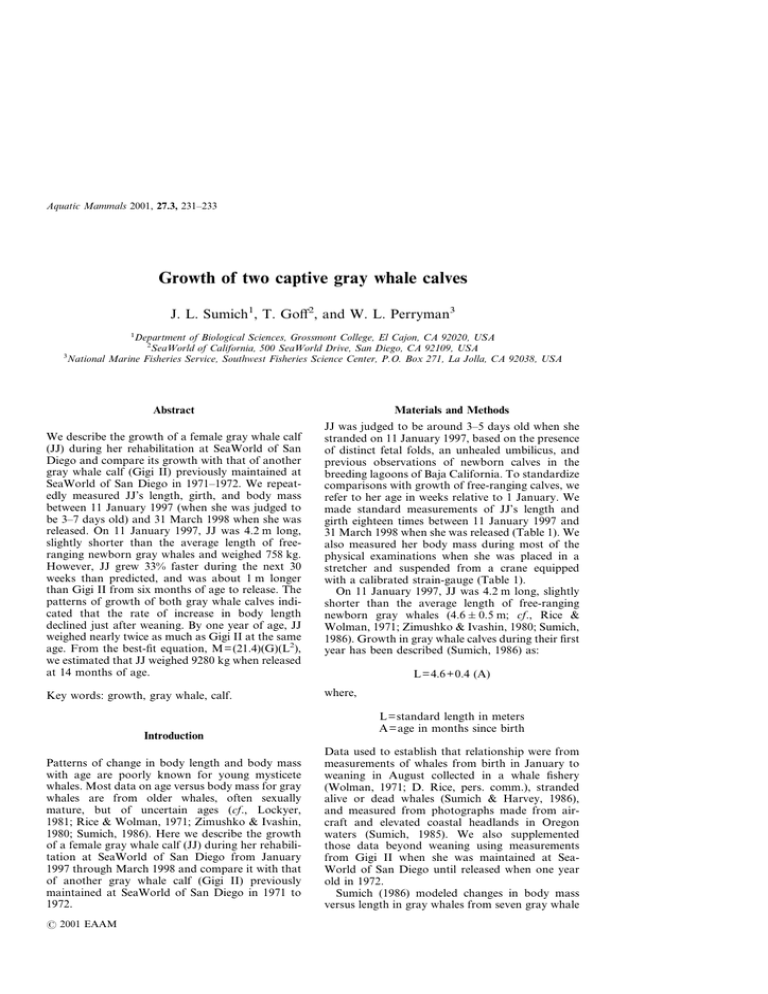Growth of two captive gray whale calves
advertisement

Aquatic Mammals 2001, 27.3, 231–233 Growth of two captive gray whale calves J. L. Sumich1, T. Goff2, and W. L. Perryman3 1 Department of Biological Sciences, Grossmont College, El Cajon, CA 92020, USA 2 SeaWorld of California, 500 SeaWorld Drive, San Diego, CA 92109, USA National Marine Fisheries Service, Southwest Fisheries Science Center, P.O. Box 271, La Jolla, CA 92038, USA 3 Materials and Methods Abstract We describe the growth of a female gray whale calf (JJ) during her rehabilitation at SeaWorld of San Diego and compare its growth with that of another gray whale calf (Gigi II) previously maintained at SeaWorld of San Diego in 1971–1972. We repeatedly measured JJ’s length, girth, and body mass between 11 January 1997 (when she was judged to be 3–7 days old) and 31 March 1998 when she was released. On 11 January 1997, JJ was 4.2 m long, slightly shorter than the average length of freeranging newborn gray whales and weighed 758 kg. However, JJ grew 33% faster during the next 30 weeks than predicted, and was about 1 m longer than Gigi II from six months of age to release. The patterns of growth of both gray whale calves indicated that the rate of increase in body length declined just after weaning. By one year of age, JJ weighed nearly twice as much as Gigi II at the same age. From the best-fit equation, M=(21.4)(G)(L2), we estimated that JJ weighed 9280 kg when released at 14 months of age. Key words: growth, gray whale, calf. Introduction Patterns of change in body length and body mass with age are poorly known for young mysticete whales. Most data on age versus body mass for gray whales are from older whales, often sexually mature, but of uncertain ages (cf., Lockyer, 1981; Rice & Wolman, 1971; Zimushko & Ivashin, 1980; Sumich, 1986). Here we describe the growth of a female gray whale calf (JJ) during her rehabilitation at SeaWorld of San Diego from January 1997 through March 1998 and compare it with that of another gray whale calf (Gigi II) previously maintained at SeaWorld of San Diego in 1971 to 1972. ? 2001 EAAM JJ was judged to be around 3–5 days old when she stranded on 11 January 1997, based on the presence of distinct fetal folds, an unhealed umbilicus, and previous observations of newborn calves in the breeding lagoons of Baja California. To standardize comparisons with growth of free-ranging calves, we refer to her age in weeks relative to 1 January. We made standard measurements of JJ’s length and girth eighteen times between 11 January 1997 and 31 March 1998 when she was released (Table 1). We also measured her body mass during most of the physical examinations when she was placed in a stretcher and suspended from a crane equipped with a calibrated strain-gauge (Table 1). On 11 January 1997, JJ was 4.2 m long, slightly shorter than the average length of free-ranging newborn gray whales (4.6&0.5 m; cf., Rice & Wolman, 1971; Zimushko & Ivashin, 1980; Sumich, 1986). Growth in gray whale calves during their first year has been described (Sumich, 1986) as: L=4.6+0.4 (A) where, L=standard length in meters A=age in months since birth Data used to establish that relationship were from measurements of whales from birth in January to weaning in August collected in a whale fishery (Wolman, 1971; D. Rice, pers. comm.), stranded alive or dead whales (Sumich & Harvey, 1986), and measured from photographs made from aircraft and elevated coastal headlands in Oregon waters (Sumich, 1985). We also supplemented those data beyond weaning using measurements from Gigi II when she was maintained at SeaWorld of San Diego until released when one year old in 1972. Sumich (1986) modeled changes in body mass versus length in gray whales from seven gray whale 232 J. L. Sumich et al. Table 1. Measurements of standard length (L), maximum girth (Gmax), and body mass (M) for a rehabilitating California gray whale calf (JJ). Date Estimated age (weeks from 1 Jan) L (cm) 0.5 1.5 3 5 7 9 11 13 15 17 19 23 28 31 35 40 44 63 422 424 447 472 493 513 546 568 594 616 638 686 732 765 795 805 838 943 1 Jan 1997 17 Jan 1997 28 Jan 1997 11 Feb 1997 26 Feb 1997 11 March 1997 25 March 1997 8 April 1997 22 April 1997 6 May 1997 20 May 1997 17 June 1997 22 July 1997 11 August 1997 9 Sept 1997 14 Oct 1997 11 Nov 1997 21 March 1997 1 Gmax (cm) Gmax:L (cm) 222 224 236 249 272 0.50 0.47 0.48 0.49 0.50 304 0.51 333 366 373 0.52 0.53 0.51 381 434 465 490 0.48 0.54 0.55 0.52 M (kg) 758 803 982 1168 1297 1465 1660 1924 2187 2523 2860 3534 4355 4799 6781 92801 Estimated from regression equation M (kg)=2.14(L2)(Gmax). carcasses. Mass of non-pregnant animals was predicted to change with length and girth as: M=(18.7)(G)(L2) where, M=body mass in kg G=maximum girth in m L=standard length in m Finally, we assessed the dynamics of the relationship between maximum girth and maximum body diameter, a measure often available from photographs made from aircraft. We used Hi-8 mm cameras to document JJ’s dorsal, ventral, and lateral dimensions at the area of maximum body diameter (Dmax) on 16 May and 25 July 1997. We digitized single frames from each video sequence made as JJ rotated around her long-axis in front of the viewing window. We measured maximum diameter to the nearest 0.1 mm with Adobe Illustrator> software. JJ weighed 758 kg when first measured on 11 January 1997, the day she arrived at SeaWorld, when she was judged to be 3–7 days old. There are no measurements of free-ranging gray whales at a similar age. The growth (mass) regression predicted that she should have weighed approximately 829 kg on 28 January, when the first measurement of girth was made, and around 2158 kg in early September, when around 9 months old and expected to wean. She was a little heavier on 28 January (982 kg) than predicted and nearly twice as heavy as predicted when 9 months old (Fig. 2). She also weighed nearly twice as much as Gigi II when they were both one Results Despite being shorter than most newborn gray whales, JJ grew about 33% faster during the next 30 weeks than predicted (Fig. 1). Moreover, JJ was around 1 m longer than Gigi II from six months to one year of age. Figure 1. Changes in body length (L) with age for two California gray whale calves (JJ=diamonds and regression; Gigi II=squares). Growth in gray whale calf Figure 2. Changes in body mass (M) with age for two California gray whale calves (JJ=diamonds and regression; Gigi II=squares). year old (Fig. 2). We found that changes in weight, length, and girth for JJ were best described as: M=(21.4)(G)(L2) From that equation, we estimated that JJ weighed around 9280 kg when released on 31 March 1998 and approximately 14 months old. Her mass then exceeded the capacity of strain-gauges available for weighing. We obtained three pairs of clear video images of JJ’s left and ventral aspects on 16 May. From those, we calculated the ratio of maximum lateral to maximum ventral diameter to be 1.058, on average. Three more comparisons on 25 July resulted in an average ratio of 99.996. The largest Dmax measured was 152 cm. Discussion We believe the difference between the two predictive growth models (i.e., Sumich, 1986 and the JJ model above) could owe to overestimates of maximum girth in whale carcasses from the accumulation of gases that accompany tissue decomposition soon after death. Consequently, we think that the model derived from JJ’s growth gives a better general estimate of non-pregnant whale mass. Our data suggested that a cross-section of the body at the location of maximum girth is roughly circular, a key assumption in estimating girth from aerial photographs. Because girth was calculated as the circumference of a circle of diameter Dmax, we estimated JJ’s maximum girth (Gmax) to be 478 cm. That was about 3% less than the measured Gmax on 21 March 1998 (=490 cm, Table 1). Consequently, we think that the assumption that the cross-section of the body of gray whales is roughly circular is reasonable and that Dmax is a good estimate of 233 Gmax, at least for young gray whales. Moreover, we believe that measurements from aerial photographs may be suitable for estimating standard length, girth, and body mass of free-ranging gray whales and to evaluate growth in young whales relative to variable environmental conditions. The pattern of growth of the two captive gray whale calves, JJ and Gigi II, suggested that the rate of increase in body length declined just after weaning. That pattern is similar to those reported for other mysticete whales (Lockyer, 1976). JJ; however, grew in length and mass faster with age than Gigi II. Gigi II was about 8 m long when one year old compared to 9 m for JJ. Rice and Wolman (1971) suggested that one-year old gray whales are around 9 to 10 m long. Moreover, based on lengths and growth layers in earplugs of stranded or harvested whales, they concluded that two growth layer groups (GLGs; see Perrin & Myrick, 1980) in ear-plugs represented one year of growth. In contrast, Sumich (1986) reasoned from Gigi II’s growth pattern that one-year old gray whales are about 8 m long and that one GLG represented one year of growth. Additional data from known-age gray whales are needed to resolve these contrasting interpretations. Acknowledgments We thank the Animal Care Department staff at SeaWorld of San Diego for their assistance, support, and access to measurement data of JJ. Literature Cited Lockyer, C. (1976) Body weights of some species of large whales. J. Cons. Int. Explor. Mer. 36, 259–273. Lockyer, C. (1981) Growth and energy budgets of large baleen whales from the Southern Hemisphere. In: Mammals in the Sea, pp. 379–487. United Nations F.A.0. Advisory Committee on Marine Resources Research: Rome. Perrin, W. F. & Myrick, A. C. (eds.) (1980) Growth of odontocetes and sirenians: Problems in age determination. Int. Whal. Comm. Spec. Iss. 3, 1–229. Rice, D. W. & Wolman, A. A. (1971) The life history and ecology of the gray whale (Eschrichtius robustus). Am. Soc. Mamm. Spec. Publ. 3, 1–142. Sumich, J. L. (1985) Gray whales along the Oregon coast in summer, 1977–1980. Murrelet 65, 33–40. Sumich, J. L. (1986) Growth in young gray whales (Eschrichtius robustus). Mar. Mamm. Sci. 2, 145–152. Sumich, J. L. & Harvey, J. T. (1986) Juvenile mortality in gray whales (Eschrichtius robustus). J. Mamm. 67, 179– 182. Zimushko, V. V. & Ivashin, M. V. (1980) Some results of U.S.S.R. investigations and whaling of gray whales (Eschrichtius robustus, Lilljeborg 1861). Rept. Int. Whal. Comm. 30, 237–246.



